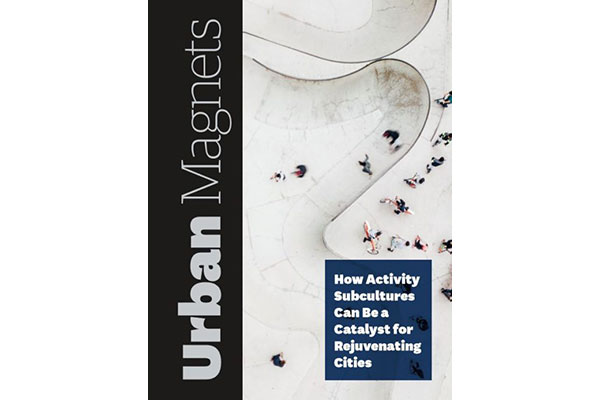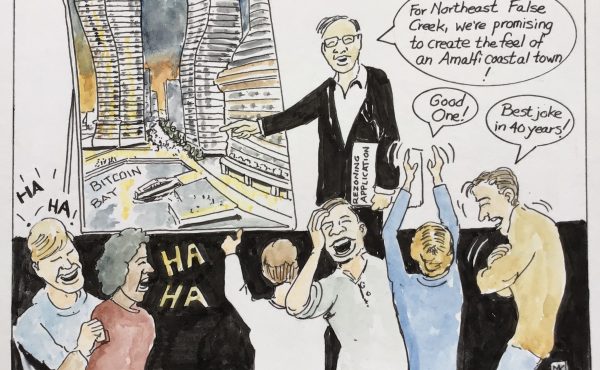
Authors: Bruce Haden, Mark Holland and Bruce Irvine (Urban Magnets Press 2020)
Urban Magnets: How Activity Subcultures Can Be a Catalyst for Rejuvenating Cities by Burce Haden, Mark Holland and Bruce Irvine is a book that bursts with energy but was born out of frustration with the urban planning and architecture zeitgeist. The authors are well-known Vancouver planners and architects who also greatly influenced making one of the city’s most vibrant spaces, Granville Island. After years of practice, the authors were frustrated that despite some exciting evolution in thought around placemaking and urban design, great spaces were still failing to materialize. They were bored of seeing the same ideas circulate in urbanist channels with no real progress of thought or tangible outcome. The conversation had become as predictable as the first sneckdown post of winter, lacking true connection with the people that make places tick. Without action, the conversation becomes dull. Does knowing what sneckdown is create lovelier spaces? Or is it something else? The book was written as a manual for those seeking to make a difference through the creation of “Urban Magnets.”
So, what is an Urban Magnet?
According to the authors, an Urban Magnet is a place people are drawn to because it is inhabited by people and activities focused around a specific activity. They argue that people are inherently interesting when they do something they love, and when left alone, subcultures grow. That is, people love to visit places where “activity subcultures” flourish. They encourage people to watch and interact with something unfamiliar. The Urban Magnet is a place that is shaped, programmed and incentivized to allow existing subcultures to flourish.
With this in mind, the main benefit of an Urban Magnet is attracting people to specific spaces. As outlined in the book, well-known urban magnets include 6th Street in Austin, TX, the RAW Temple District in Berlin and Venice Beach in Los Angeles. In each of these, a magnet is created through a thoughtful combination of design and programming of a place around an activity subculture. When people are genuinely interested in a place, it is sustained because of its unique identity and relevant opportunities for retail, food and interaction. Over and above its economic benefits, magnets can also increase the relative safety of an area through increased pedestrian traffic and eyes on the street.
Although some places naturally seem to exude a special magnetism, the authors insist that magnets can be created intentionally. The book, therefore, provides a recipe for creating Magnets through illustrative examples and “attractor elements.” As stated within, much of current urban planning and architecture is obsessed with creating vibrant, mixed-use, walkable neighbourhoods. However, looking beyond the perpetually bustling sunny day renderings, there is seldom a road map for achieving true vibrancy. Putting people in spaces doesn’t automatically make them vibrant.
The most important element of an Urban Magnet is authenticity. Finding and centring a place around an activity subculture must be genuine and involve those identifying with it. Planners need to learn more about the subculture and understand why people find it interesting. The book outlines “Six Elements of Attractor Places” essential to creating Urban Magnets:
- Identify the activity sub-culture that makes the place unique
- What specialty retail supports the activity?
- Is there space to support production related to the subculture?
- Is there a place to learn about it?
- Are there programming and events to showcase the activity?
- Unique urban form that brings it to life
Lastly, it is essential to tease out consumer-focused versus producer-focused elements. On Granville Island, for example, the magnets are the arts, boating and food. Each of the six attractor elements is present for each activity subculture, and the mixture of these subcultures allows it to flourish. Additionally, the programming and planning for each magnet is focused on the producer, not the selling. Make no mistake, there is a lot of selling going on, but how the space has been designed, leased and programmed allows producers to remain and thrive, arguably enabling the island’s enduring success. As put in the book, life is in the making.
Contrary to popular thought about making places appealing and attractive to the broadest range of people, Urban Magnets states plainly, “When you design for everyone – you design for no one.” Instead, by designing for a specific activity subculture, the authors successfully argue that it is possible to create a space that piques interest and curiosity and invites others to be transformed. As planners, engineers and architects, the concept of urban magnets is an excellent reminder to be thoughtful about the people we design for.
***
You can learn more about Urban Magnets by going to the Urban Magnets website.
**
Andrew Cuthbert is a community planner who works on land use plans, zoning bylaws, and active transportation plans all over British Columbia. He loves helping communities solve problems. When not working, Andrew can most likely be found on his bike taking in the sights and fresh air.



